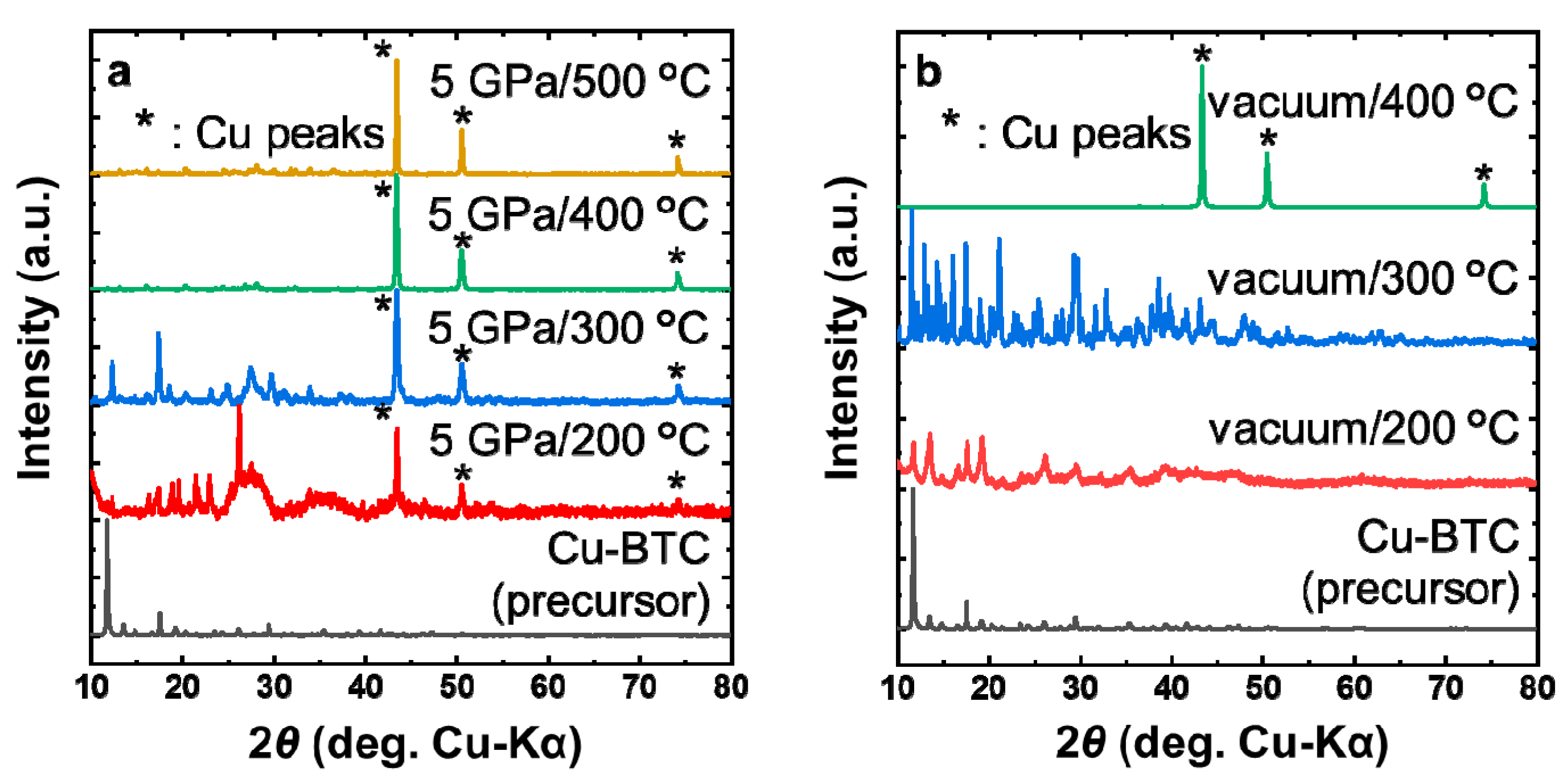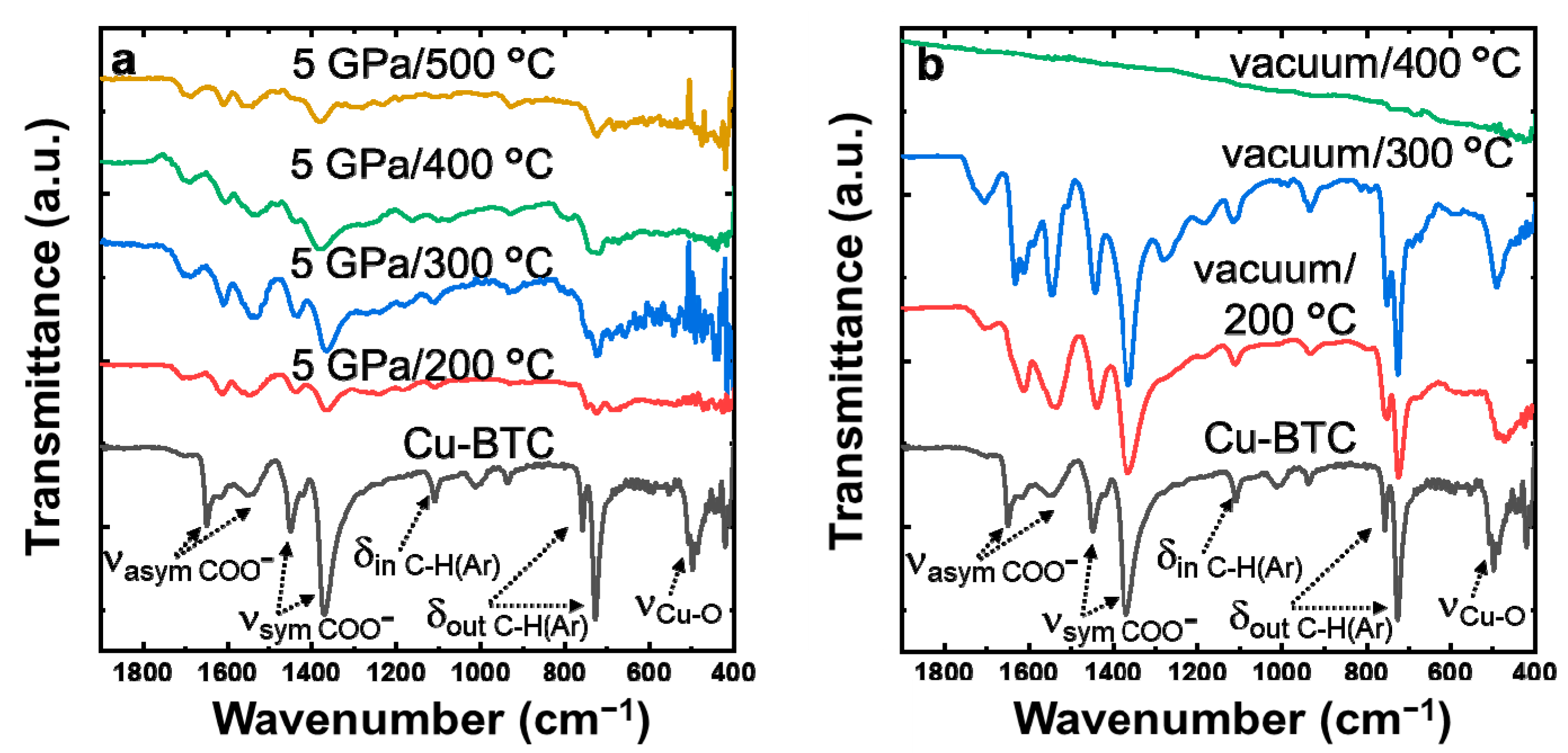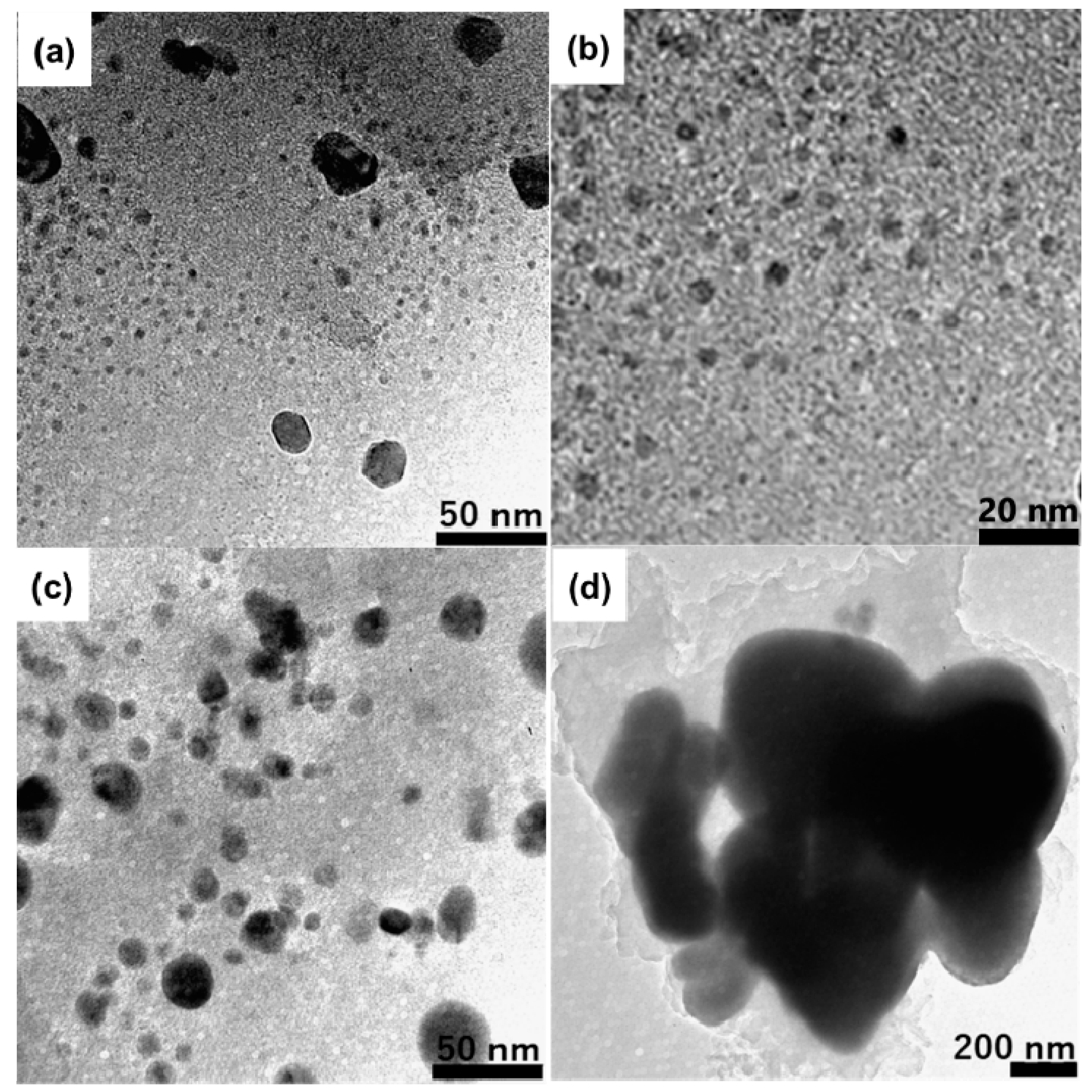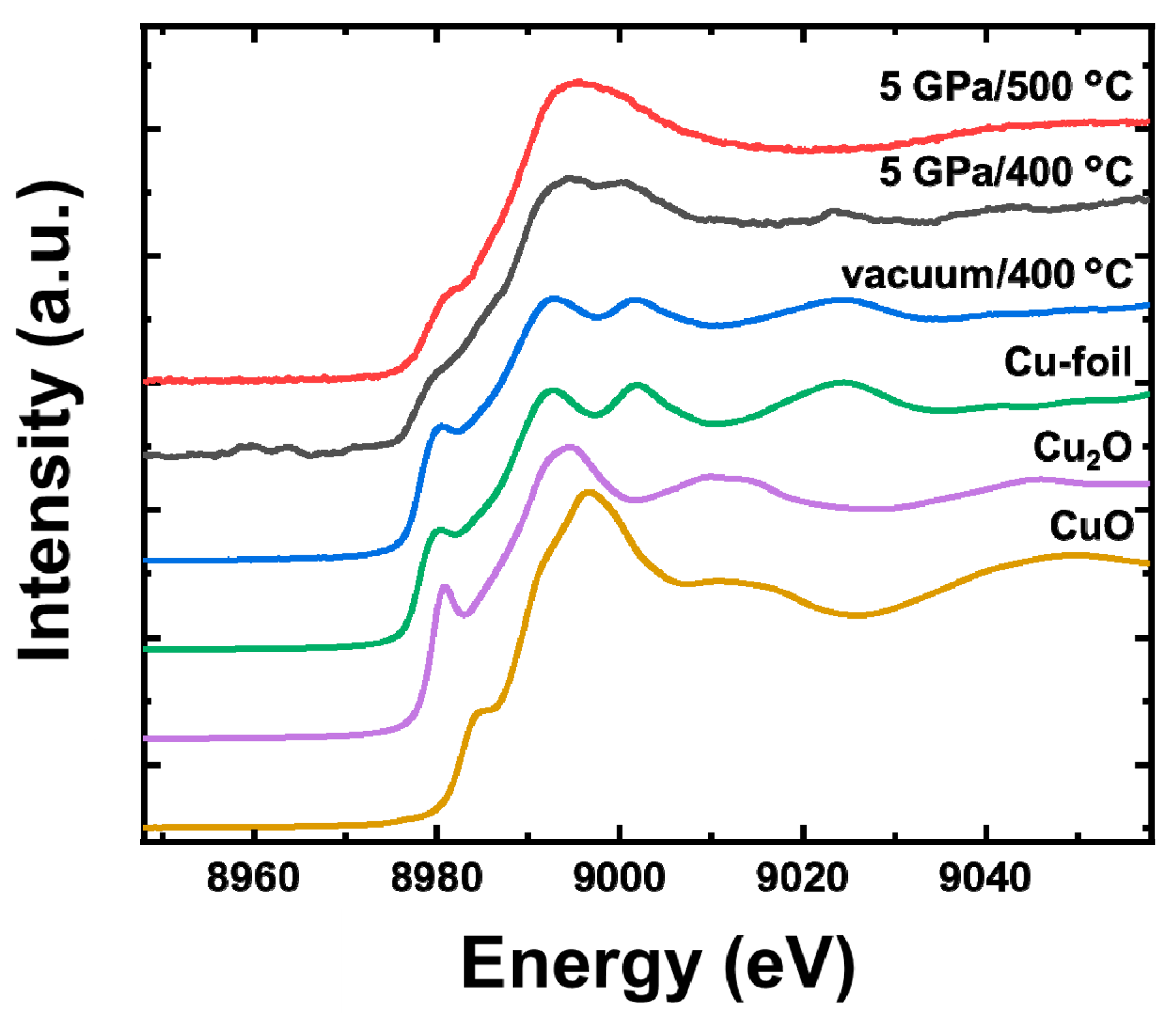Ultrahigh-Pressure Preparation and Catalytic Activity of MOF-Derived Cu Nanoparticles
Abstract
1. Introduction
2. Materials and Methods
3. Results and Discussion
4. Conclusions
Supplementary Materials
Author Contributions
Funding
Data Availability Statement
Conflicts of Interest
References
- Hassan, J.; Sévignon, M.; Gozzi, C.; Schulz, E.; Lemaire, M. Aryl-Aryl Bond Formation One Century after the Discovery of the Ullmann Reaction. Chem. Rev. 2002, 102, 1359–1469. [Google Scholar] [CrossRef]
- Thathagar, M.B.; Beckers, J.; Rothenberg, G. Copper-Catalyzed Suzuki Cross-Coupling Using Mixed Nanocluster Catalysts. J. Am. Chem. Soc. 2002, 124, 11858–11859. [Google Scholar] [CrossRef]
- Thathagar, M.B.; Beckers, J.; Rothenberg, G. Palladium-Free and Ligand-Free Sonogashira Cross-Coupling. Green Chem. 2004, 6, 215–218. [Google Scholar] [CrossRef]
- Lakshmi Kantam, M.; Swarna Jaya, V.; Jaya Lakshmi, M.; Reddy, B.R.; Choudary, B.M.; Bhargava, S.K. Alumina Supported Copper Nanoparticles for Aziridination and Cyclopropanation Reactions. Catal. Commun. 2007, 8, 1963–1968. [Google Scholar] [CrossRef]
- Alonso, F.; Moglie, Y.; Radivoy, G.; Yus, M. Multicomponent Synthesis of 1,2,3-Triazoles in Water Catalyzed by Copper Nanoparticles on Activated Carbon. Adv. Synth. Catal. 2010, 352, 3208–3214. [Google Scholar] [CrossRef]
- Kidwai, M.; Mishra, N.K.; Bansal, V.; Kumar, A.; Mozumdar, S. Cu-Nanoparticle Catalyzed O-Arylation of Phenols with Aryl Halides via Ullmann Coupling. Tetrahedron Lett. 2007, 48, 8883–8887. [Google Scholar] [CrossRef]
- Bhadra, S.; Saha, A.; Ranu, B.C. One-Pot Copper Nanoparticle-Catalyzed Synthesis of S-Aryl- and S-Vinyl Dithiocarbamates in Water: High Diastereoselectivity Achieved for Vinyl Dithiocarbamates. Green Chem. 2008, 10, 1224–1230. [Google Scholar] [CrossRef]
- Kidwai, M.; Bansal, V.; Saxena, A.; Aerry, S.; Mozumdar, S. Cu-Nanoparticles: Efficient Catalysts for the Oxidative Cyclization of Schiffs’ Bases. Tetrahedron Lett. 2006, 47, 8049–8053. [Google Scholar] [CrossRef]
- Li, X.; Cai, W.; An, J.; Kim, S.; Nah, J.; Yang, D.; Piner, R.; Velamakanni, A.; Jung, I.; Tutuc, E.; et al. Large-Area Synthesis of High-Quality and Uniform Graphene Films on Copper Foils. Science 2009, 324, 1312–1314. [Google Scholar] [CrossRef]
- Sun, Z.; Yan, Z.; Yao, J.; Beitler, E.; Zhu, Y.; Tour, J.M. Growth of Graphene from Solid Carbon Sources. Nature 2010, 468, 549–552. [Google Scholar] [CrossRef] [PubMed]
- Lu, Q.; Rosen, J.; Zhou, Y.; Hutchings, G.S.; Kimmel, Y.C.; Chen, J.G.; Jiao, F. A Selective and Efficient Electrocatalyst for Carbon Dioxide Reduction. Nat. Commun. 2014, 5, 1–6. [Google Scholar] [CrossRef]
- Kortlever, R.; Shen, J.; Schouten, K.J.P.; Calle-Vallejo, F.; Koper, M.T.M. Catalysts and Reaction Pathways for the Electrochemical Reduction of Carbon Dioxide. J. Phys. Chem. Lett. 2015, 6, 4073–4082. [Google Scholar] [CrossRef] [PubMed]
- Iwamoto, M.; Hamada, H. Removal of Nitrogen Monoxide From Exhaust Gases Through Novel Catalytic Processes. Catal. Today 1991, 10, 57–71. [Google Scholar] [CrossRef]
- Kašpar, J.; Fornasiero, P.; Hickey, N. Automotive: Catalytic Converters Current Status. Catal. Today 2003, 77, 419–449. [Google Scholar] [CrossRef]
- McNulty, J.; Keskar, K.; Vemula, R. The FirstWell-Defined Silver(I)-Complex-Catalyzed Cycloaddition of Azides onto Terminal Alkynes at Room Temperature. Chem. Eur. J. 2011, 17, 14727–14730. [Google Scholar] [CrossRef]
- Astruc, D.; Lu, F.; Aranzaes, J.R. Nanoparticles as Recyclable Catalysts: The Frontier between Homogeneous and Heterogeneous Catalysis. Angew. Chem. Int. Ed. 2005, 44, 7852–7872. [Google Scholar] [CrossRef] [PubMed]
- Reetz, M.T.; Maase, M. Redox-Controlled Size-Selective Fabrication of Nanostructured Transition Metal Colloids. Adv. Mater. 1999, 11, 773–777. [Google Scholar] [CrossRef]
- Ranu, B.C.; Dey, R.; Chatterjee, T.; Ahammed, S. Copper Nanoparticle-Catalyzed Carbon-Carbon and Carbon-Heteroatom Bond Formation with a Greener Perspective. ChemSusChem 2012, 5, 22–44. [Google Scholar] [CrossRef] [PubMed]
- Shen, K.; Chen, X.; Chen, J.; Li, Y. Development of MOF-Derived Carbon-Based Nanomaterials for Efficient Catalysis. ACS Catal. 2016, 6, 5887–5903. [Google Scholar] [CrossRef]
- Kim, A.; Muthuchamy, N.; Yoon, C.; Joo, S.H.; Park, K.H. MOF-Derived Cu@Cu2O Nanocatalyst for Oxygen Reduction Reaction and Cycloaddition Reaction. Nanomaterials 2018, 8, 138. [Google Scholar] [CrossRef]
- Han, A.; Wang, B.; Kumar, A.; Qin, Y.; Jin, J.; Wang, X.; Yang, C.; Dong, B.; Jia, Y.; Liu, J.; et al. Recent Advances for MOF-Derived Carbon-Supported Single-Atom Catalysts. Small Methods 2019, 3. [Google Scholar] [CrossRef]
- Liu, H.; Zhang, S.; Liu, Y.; Yang, Z.; Feng, X.; Lu, X.; Huo, F. Well-Dispersed and Size-Controlled Supported Metal Oxide Nanoparticles Derived from MOF Composites and Further Application in Catalysis. Small 2015, 11, 3130–3134. [Google Scholar] [CrossRef]
- Candland, C.T.; Decker, D.L.; Vanfleet, H.B. Interstitial Diffusion of Copper in Lead at Pressures up to 56 Kbar. Phys. Rev. B 1972, 5, 2085–2094. [Google Scholar] [CrossRef]
- Peterson, N.L. Self-Diffusion in Pure Metals. J. Nucl. Mater. 1978, 69–70, 3–37. [Google Scholar] [CrossRef]
- Wang, J.; Chen, B.; Williams, Q.; Manghnani, M.H. Short- and Intermediate-Range Structure and Dynamics of Fe-Ni-C Liquid Under Compression. Front. Earth Sci. 2019, 7, 258. [Google Scholar] [CrossRef]
- Rein, G.; Mehrer, H.; Mehrer, H. Effect of Hydrostatic Pressure and Temperature on the Self-Diffusion Rate in Single Crystals of Silver and Gold. Philos. Mag. A Phys. Condens. Matter Struct. Defects Mech. Prop. 1982, 45, 467–492. [Google Scholar] [CrossRef]
- Chui, S.S.Y.; Lo, S.M.F.; Charmant, J.P.H.; Orpen, A.G.; Williams, I.D. A Chemically Functionalizable Nanoporous Material [Cu3(TMA)2 (H2O)3](N). Science 1999, 283, 1148–1150. [Google Scholar] [CrossRef] [PubMed]
- Chen, H.Y.; Wee, G.; Al-Oweini, R.; Friedl, J.; Tan, K.S.; Wang, Y.; Wong, C.L.; Kortz, U.; Stimming, U.; Srinivasan, M. A Polyoxovanadate as an Advanced Electrode Material for Supercapacitors. ChemPhysChem 2014, 15, 2162–2169. [Google Scholar] [CrossRef] [PubMed]
- Molteni, G.; Bianchi, C.L.; Marinoni, G.; Santo, N.; Ponti, A. Cu/Cu-Oxide Nanoparticles as Catalyst in the “Click” Azide-Alkyne Cycloaddition. New J. Chem. 2006, 30, 1137–1139. [Google Scholar] [CrossRef]
- Lipshutz, B.H.; Taft, B.R. Heterogeneous Copper-in-Charcoal-Catalyzed Click Chemistry. Angew. Chem. Int. Ed. 2006, 45, 8235–8238. [Google Scholar] [CrossRef]
- Zhang, X.; Li, H.; You, L.; Tang, Y.; Hsung, R.P. Copper Salt-Catalyzed Azide-[3 + 2] Cycloadditions of Ynamides and Bis-Ynamides. Adv. Synth. Catal. 2006, 348, 2437–2442. [Google Scholar] [CrossRef]
- Yan, Z.Y.; Zhao, Y.B.; Fan, M.J.; Liu, W.M.; Liang, Y.M. General Synthesis of (1-Substituted-1H-1,2,3-Triazol-4-Ylmethyl)- Dialkylamines via a Copper(I)-Catalyzed Three-Component Reaction in Water. Tetrahedron 2005, 61, 9331–9337. [Google Scholar] [CrossRef]
- Knibbe, J.S.; Luginbühl, S.M.; Stoevelaar, R.; van der Plas, W.; van Harlingen, D.M.; Rai, N.; Steenstra, E.S.; van de Geer, R.; van Westrenen, W. Calibration of a multi-anvil high-pressure apparatus to simulate planetary interior conditions. EPJ Techn. Instrum. 2018, 5, 5. [Google Scholar] [CrossRef]
- Dong, Z.; Mi, Z.; Shi, W.; Jiang, H.; Zheng, Y.; Yang, K. High Pressure Effects on Hydrate Cu-BTC Investigated by Vibrational Spectroscopy and Synchrotron X-Ray Diffraction. RSC Adv. 2017, 7, 55504–55512. [Google Scholar] [CrossRef]
- Zhang, J.; An, B.; Hong, Y.; Meng, Y.; Hu, X.; Wang, C.; Lin, J.; Lin, W.; Wang, Y. Pyrolysis of Metal-Organic Frameworks to Hierarchical Porous Cu/Zn-Nanoparticle@carbon Materials for Efficient CO2 Hydrogenation. Mater. Chem. Front. 2017, 1, 2405–2409. [Google Scholar] [CrossRef]
- Cheng, J.; Xuan, X.; Yang, X.; Zhou, J.; Cen, K. Selective Reduction of CO2 to Alcohol Products on Octahedral Catalyst of Carbonized Cu(BTC) Doped with Pd Nanoparticles in a Photoelectrochemical Cell. Chem. Eng. J. 2019, 358, 860–868. [Google Scholar] [CrossRef]
- Weng, Y.; Guan, S.; Wang, L.; Lu, H.; Meng, X.; Waterhouse, G.I.N.; Zhou, S. Defective Porous Carbon Polyhedra Decorated with Copper Nanoparticles for Enhanced NIR-Driven Photothermal Cancer Therapy. Small 2020, 16, 1–10. [Google Scholar] [CrossRef]
- Zhou, X.; Zhai, X.; Ge, G.; Dan, J.; Pan, K.; Tian, J.; Sun, R.; Dai, B.; Pfeiffer, H.; Yu, F. Enhanced Selective Catalytic Reduction of NO with CO over Cu/C Nanoparticles Synthetized from a Cu-Benzene-1,3,5-Tricarboxylate Metal Organic Framework by a Continuous Spray Drying Process. Chem. Eng. J. 2020, 388, 124270. [Google Scholar] [CrossRef]
- Bock, V.D.; Hiemstra, H.; Van Maarseveen, J.H. Cu I-Catalyzed Alkyne-Azide “Click” Cycloadditions from a Mechanistic and Synthetic Perspective. Eur. J. Org. Chem. 2006, 2006, 51–68. [Google Scholar] [CrossRef]





| Scheme | Cu Content |
|---|---|
| 5 GPa/500 °C | 63 wt% |
| 5 GPa/400 °C | 56 wt% |
| 5 GPa/300 °C | 27 wt% |
| 5 GPa/200 °C | 25 wt% |
| Vacuum/400 °C | 54 wt% |
| Vacuum/300 °C | 30 wt% |
| Vacuum/200 °C | 30 wt% |
| Synthesis Conditions | Cu | Cu2O | CuO |
|---|---|---|---|
| Atomic % | Atomic % | Atomic % | |
| 5 GPa/500 °C | 26.2 ± 1.9 | 22.6 ± 2.3 | 51.2 ±4.5 |
| 5 GPa/400 °C | 44.9 ± 4.8 | 31.9 ± 5.7 | 23.2 ± 8.3 |
| Vacuum/400 °C | 79.3 ± 1.4 | 20.7 ± 3.0 | 0.0 ± 0.9 |
| Synthesis Conditions of Catalysts | Surface Area (m2g−1) |
|---|---|
| 5 GPa/500 °C | 6.7 |
| 5 GPa/400 °C | 22.6 |
| 5 GPa/300 °C | 9.1 |
| 5 GPa/200 °C | 0.4 |
| Vacuum/400 °C | 13.6 |
| Vacuum/300 °C | 9.7 |
| Vacuum/200 °C | 124.6 |
| Cu-BTC | 937.6 |
| Synthesis Conditions of Catalysts | Yield |
|---|---|
| 5 GPa/500 °C | 28% |
| 5 GPa/400 °C | 18% |
| 5 GPa/300 °C | 16% |
| 5 GPa/200 °C | 0% |
| Vacuum/400 °C | 0% |
| Vacuum/300 °C | 0% |
| Vacuum/200 °C | 0% |
| Blank (no catalyst) | 0% |
Publisher’s Note: MDPI stays neutral with regard to jurisdictional claims in published maps and institutional affiliations. |
© 2021 by the authors. Licensee MDPI, Basel, Switzerland. This article is an open access article distributed under the terms and conditions of the Creative Commons Attribution (CC BY) license (https://creativecommons.org/licenses/by/4.0/).
Share and Cite
Yamane, I.; Sato, K.; Otomo, R.; Yanase, T.; Miura, A.; Nagahama, T.; Kamiya, Y.; Shimada, T. Ultrahigh-Pressure Preparation and Catalytic Activity of MOF-Derived Cu Nanoparticles. Nanomaterials 2021, 11, 1040. https://doi.org/10.3390/nano11041040
Yamane I, Sato K, Otomo R, Yanase T, Miura A, Nagahama T, Kamiya Y, Shimada T. Ultrahigh-Pressure Preparation and Catalytic Activity of MOF-Derived Cu Nanoparticles. Nanomaterials. 2021; 11(4):1040. https://doi.org/10.3390/nano11041040
Chicago/Turabian StyleYamane, Ichiro, Kota Sato, Ryoichi Otomo, Takashi Yanase, Akira Miura, Taro Nagahama, Yuichi Kamiya, and Toshihiro Shimada. 2021. "Ultrahigh-Pressure Preparation and Catalytic Activity of MOF-Derived Cu Nanoparticles" Nanomaterials 11, no. 4: 1040. https://doi.org/10.3390/nano11041040
APA StyleYamane, I., Sato, K., Otomo, R., Yanase, T., Miura, A., Nagahama, T., Kamiya, Y., & Shimada, T. (2021). Ultrahigh-Pressure Preparation and Catalytic Activity of MOF-Derived Cu Nanoparticles. Nanomaterials, 11(4), 1040. https://doi.org/10.3390/nano11041040






